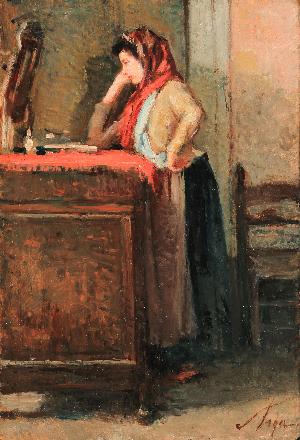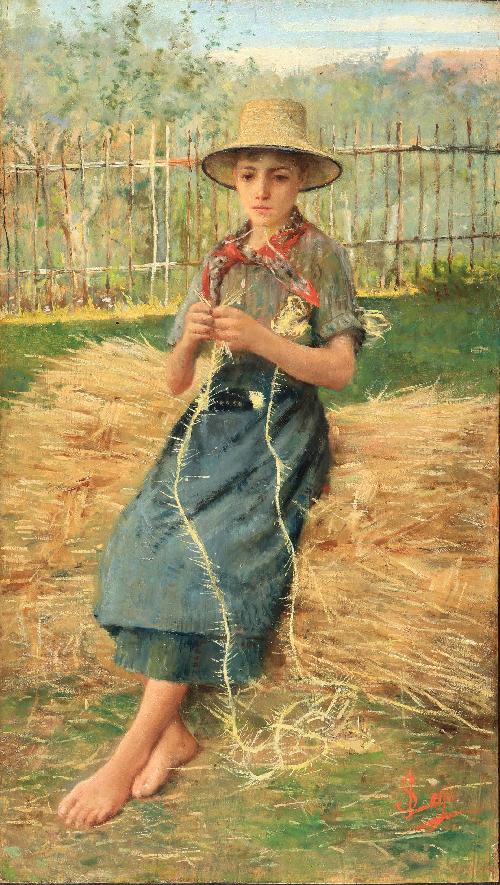LEGA SILVESTRO
MODIGLIANA (FO) 1826 - FLORENCE 1895
Born in Modigliana (Forlì) on 4 December 1826, he died very poor in the Florence hospital on 21 September 1895. He first studied in Florence with Enrico Pollastrini, from whom he soon broke away to continue with Luigi Mussini who ran a private school. The latter advised him to study the primitives, thus directing him towards great probity of design and clarity of color. After fighting in 1848 at Curtatone and Montanara, Lega returned to Florence and resumed his studies under the direction of Antonio Ciseri. When Macchiaiolism appeared, he first denied this new school, then followed it by studying from life on the Fiesole mountains. Around the age of fifty he reached the peak of his art, and the color reached luxuriant beauty in his works. Then, perhaps due to his visual weakness, "his brushstroke became more visible and sharp, his vision less attentive and faster" (Ugo Ojetti). He was the painter who gave everything and asked nothing of art. He produced clear genre paintings choosing the most common and innocent subjects; he was a portrait painter, but not a commissioned portrait painter, observes Mario Tinti, «and he knew how to grasp that inner character which can sometimes even be a disturbing revelation, and therefore unwelcome, for the rightful owner of the depicted physiognomy! ». Among his works are: King Saul appeased by David's harp; Portrait of the members of the Fabbioni family; the four lunettes depicting the Scourges (1858), for the Oratorio della Madonna del Cantone in Modigliana, where they are still located; Titian and Irene of Spilimbergo; two studies: Impression of the village in Pergentina and Loggia rustica in Pergentina (1861), and Signora Virginia Batelli (1861), in the Galleria d'Arte Moderna in Milan; and in the Pinacoteca di Brera The conversation in the garden; sketch for the painting The piano lesson (1862), property of G. A. Borgese of Milan; Il canto dello stornello, awarded with a silver medal at the Parma Exposition of 1870, now owned by Valgimigli di Terranova Bracciolini; II after lunch (1868), formerly in the collection of Eng. Rosselli of Viareggio; The visit (1868), in the Galleria d'Arte Moderna in Rome; Portraits of members of the Cecchini family, property of Signora Cecchini Tommasi of Florence; The visit to the nurse (1873), in the Gallery of Modern Art in Florence; The sculptor Carmelo (1878), property Carnielo of Florence; The painter Francesco Gioii (1879), owned by Bertini of Florence; On the lawn (1883), in the Baer collection in Milan; Case farmhouse and haystacks (1885), also in the Baer collection, where the seated peasant woman is also found on the edge of the field (1890); La ciociara (1883), in the Vannini Parenti collection in Florence; Impression of a figure of a woman (1880), in that of Signor F. Pasi, at the Ardenza in Livorno; Don Giovanni Verità (1885), the priest who in 1849 saved Garibaldi pursued by the Popes, belonging to the Municipality of Modigliana; Portrait of Rosa (1890), in the Conti de' Nobili collection in Florence; Lady with a Fan (1890); La veglia (1890), owned by C. Gerunda of Milan; The villain, in the Cremoni collection in Florence; Conta-dinelli, in the collection of the comm. Delleani of Carignano; The solicitor; The garden party; The engaged couple, in the collection of Signor Guido Rossi; The girls who play ladies and Newlyweds in the farmyard, in that of the comm. Carlo Clausetti of Milan.
©2015 ENRICO Gallerie d'Arte - All Right Reserved - P.IVA 00985970094 | Privacy Policy | Cookie Policy | Site Map


